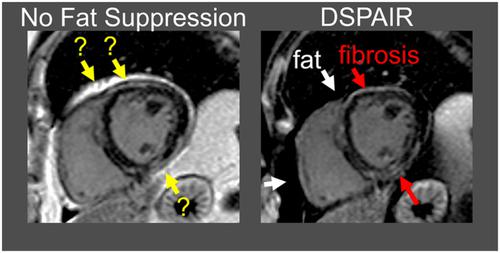当前位置:
X-MOL 学术
›
NMR Biomed.
›
论文详情
Our official English website, www.x-mol.net, welcomes your feedback! (Note: you will need to create a separate account there.)
Double spectral attenuated inversion recovery (DSPAIR)—an efficient fat suppression technique for late gadolinium enhancement at 3 tesla
NMR in Biomedicine ( IF 2.9 ) Pub Date : 2021-07-12 , DOI: 10.1002/nbm.4580 Elizabeth R Jenista 1 , Christoph J Jensen 1 , David Wendell 1 , Deneen Spatz 1, 2 , Stephen Darty 1 , Han W Kim 1 , Michele Parker 1 , Igor Klem 1 , Enn-Ling Chen 1 , Raymond J Kim 1 , Wolfgang G Rehwald 1, 3
NMR in Biomedicine ( IF 2.9 ) Pub Date : 2021-07-12 , DOI: 10.1002/nbm.4580 Elizabeth R Jenista 1 , Christoph J Jensen 1 , David Wendell 1 , Deneen Spatz 1, 2 , Stephen Darty 1 , Han W Kim 1 , Michele Parker 1 , Igor Klem 1 , Enn-Ling Chen 1 , Raymond J Kim 1 , Wolfgang G Rehwald 1, 3
Affiliation

|
Despite clinical use of late gadolinium enhancement (LGE) for two decades, an efficient, robust fat suppression (FS) technique still does not exist for this CMR mainstay. In ischemic and non-ischemic heart disease, differentiating fibrotic tissue from infiltrating and adjacent fat is crucial. Multiple groups have independently developed an FS technique for LGE, double spectral attenuated inversion recovery (DSPAIR), but no comprehensive evaluation was performed. This study aims to fill this gap. DSPAIR uses two SPAIR pulses and one non-selective IR pulse to enable FS LGE, including compatibility with phase sensitive inversion recovery (PSIR). We implemented a magnitude (MAGN) and a PSIR variant and compared them with LGE without FS (CONTROL) and with spectral presaturation with inversion recovery (SPIR) in simulations, phantoms, and patients. Fat magnetization by SPIR, MAGN DSPAIR, and PSIR DSPAIR was simulated as a function of pulse B1, readout (RO) pulse number, and fat TI. A phantom with fat, fibrosis, and myocardium compartments was imaged using all FS methods and modifying pulse B1, RO pulse number, and heart rate. Signal was measured in SNR units. Fat, myocardium, and fibrosis SNR and fibrosis-to-fat CNR were obtained. Patient images were acquired with all FS techniques. Fat, myocardium, and fibrosis SNR, fibrosis-to-fat CNR, and image and FS quality were assessed. In the phantom, both DSPAIR variants provided superior FS compared with SPIR, independent of heart rate and RO pulse number. MAGN DSPAIR reduced fat signal by 99% compared with CONTROL, PSIR DSPAIR by 116%, and SPIR by 67% (25 RO pulses). In patients, both DSPAIR variants substantially reduced fat signal (MAGN DSPAIR by 87.1% ± 10.0%, PSIR DSPAIR by 130.5% ± 36.3%), but SPIR did not (35.8% ± 25.5%). FS quality was good to excellent for MAGN and PSIR DSPAIR, and moderate to poor for SPIR. DSPAIR provided highly effective FS across a wide range of parameters. PSIR DSPAIR performed best.
中文翻译:

双光谱衰减反转恢复 (DSPAIR) — 一种有效的脂肪抑制技术,用于 3 特斯拉的晚期钆增强
尽管临床使用晚期钆增强 (LGE) 已有 20 年之久,但对于这种 CMR 支柱,仍然不存在一种有效、强大的脂肪抑制 (FS) 技术。在缺血性和非缺血性心脏病中,区分纤维化组织与浸润性脂肪和邻近脂肪至关重要。多组独立开发了LGE的FS技术,双谱衰减反转恢复(DSPAIR),但未进行综合评价。本研究旨在填补这一空白。DSPAIR 使用两个 SPAIR 脉冲和一个非选择性 IR 脉冲来启用 FS LGE,包括与相敏反转恢复 (PSIR) 的兼容性。我们实施了幅度 (MAGN) 和 PSIR 变体,并将它们与没有 FS (CONTROL) 的 LGE 以及在模拟、模型和患者中具有反转恢复 (SPIR) 的光谱预饱和进行了比较。B 1,读出(RO)脉冲数,和脂肪T I。使用所有 FS 方法和修改脉冲B 1对具有脂肪、纤维化和心肌隔室的体模进行成像、RO 脉冲数和心率。信号以 SNR 为单位测量。获得了脂肪、心肌和纤维化 SNR 和纤维化-脂肪 CNR。使用所有 FS 技术获取患者图像。评估了脂肪、心肌和纤维化 SNR、纤维化至脂肪 CNR 以及图像和 FS 质量。在体模中,与 SPIR 相比,两种 DSPAIR 变体都提供了更好的 FS,与心率和 RO 脉冲数无关。与 CONTROL 相比,MAGN DSPAIR 减少了 99% 的脂肪信号,PSIR DSPAIR 减少了 116%,SPIR 减少了 67%(25 个 RO 脉冲)。在患者中,两种 DSPAIR 变体均显着降低了脂肪信号(MAGN DSPAIR 降低了 87.1% ± 10.0%,PSIR DSPAIR 降低了 130.5% ± 36.3%),但 SPIR 没有(35.8% ± 25.5%)。FS 质量对于 MAGN 和 PSIR DSPAIR 来说是好到极好,对于 SPIR 来说是中等到差。DSPAIR 在广泛的参数范围内提供了高效的 FS。
更新日期:2021-09-08
中文翻译:

双光谱衰减反转恢复 (DSPAIR) — 一种有效的脂肪抑制技术,用于 3 特斯拉的晚期钆增强
尽管临床使用晚期钆增强 (LGE) 已有 20 年之久,但对于这种 CMR 支柱,仍然不存在一种有效、强大的脂肪抑制 (FS) 技术。在缺血性和非缺血性心脏病中,区分纤维化组织与浸润性脂肪和邻近脂肪至关重要。多组独立开发了LGE的FS技术,双谱衰减反转恢复(DSPAIR),但未进行综合评价。本研究旨在填补这一空白。DSPAIR 使用两个 SPAIR 脉冲和一个非选择性 IR 脉冲来启用 FS LGE,包括与相敏反转恢复 (PSIR) 的兼容性。我们实施了幅度 (MAGN) 和 PSIR 变体,并将它们与没有 FS (CONTROL) 的 LGE 以及在模拟、模型和患者中具有反转恢复 (SPIR) 的光谱预饱和进行了比较。B 1,读出(RO)脉冲数,和脂肪T I。使用所有 FS 方法和修改脉冲B 1对具有脂肪、纤维化和心肌隔室的体模进行成像、RO 脉冲数和心率。信号以 SNR 为单位测量。获得了脂肪、心肌和纤维化 SNR 和纤维化-脂肪 CNR。使用所有 FS 技术获取患者图像。评估了脂肪、心肌和纤维化 SNR、纤维化至脂肪 CNR 以及图像和 FS 质量。在体模中,与 SPIR 相比,两种 DSPAIR 变体都提供了更好的 FS,与心率和 RO 脉冲数无关。与 CONTROL 相比,MAGN DSPAIR 减少了 99% 的脂肪信号,PSIR DSPAIR 减少了 116%,SPIR 减少了 67%(25 个 RO 脉冲)。在患者中,两种 DSPAIR 变体均显着降低了脂肪信号(MAGN DSPAIR 降低了 87.1% ± 10.0%,PSIR DSPAIR 降低了 130.5% ± 36.3%),但 SPIR 没有(35.8% ± 25.5%)。FS 质量对于 MAGN 和 PSIR DSPAIR 来说是好到极好,对于 SPIR 来说是中等到差。DSPAIR 在广泛的参数范围内提供了高效的 FS。


























 京公网安备 11010802027423号
京公网安备 11010802027423号